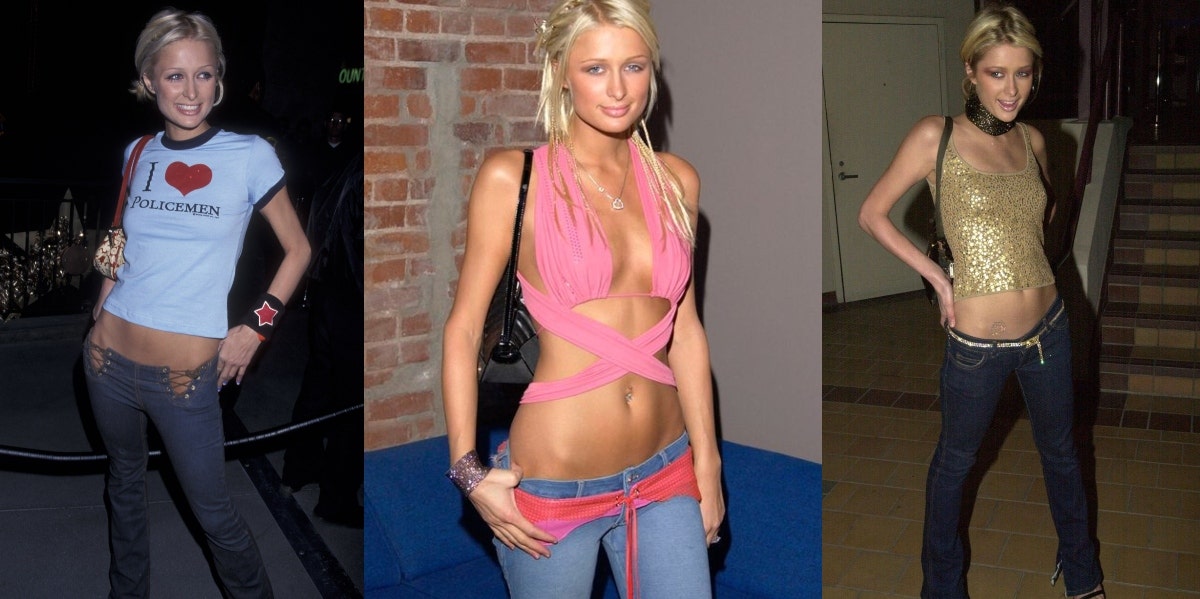Low-Rise Jeans Are Coming Back — Why People Who Wore Them In The 2000s Are Concerned
Our stomach rolls are not happy.
 Getty Images
Getty Images One of fashion’s most polarising trends is creeping its way back into our lives. Low-rise jeans have returned — and not everyone is happy about it.
Early 2000s fashion is having a mini-renaissance with the return of baby tees, cut-out tops, and now, the dreaded revival of low-rise jeans.
Those of us raised in the era of size-zero models and stomach-revealing denim-wear know all too well that fashion trends can have disastrous implications on our mental health and body image.
Are low-rise jeans coming back?
Alas, they are. And TikTok is hugely to blame (or thank, depending on your perspective) for this particular trend.
As of today, videos listed under the hashtag #lowrisejeans have been viewed over 34.9 million times on the app, with fashion influencers regularly posting clips of themselves showing off low-rise thrift shop finds.
Listen, fashion trends are an aspect of democracy anyone can partake in and there should be nothing stopping a curvy girl from donning a pair of low-rise Levis.
But the trend does promote a particular body type that isn’t attainable for everyone.
Those fearing the return of low-rise jeans have already expressed concerns about wearing them due to their self-identified stomach rolls and love handles.
The trend seems to be causing us to worry about all the parts we've been happily tucking away in our high-rise and mom jeans.
To put it frankly, Millennials are terrified of the potentially toxic effect of low-rise jeans.
The TikTok generation was still learning to walk when the Paris Hiltons and Nicole Richies of the world were strutting their stuff in low-rise skinny jeans, flares, and Juicy Couture.
And for some of those who felt pressured to squeeze into these jeans for high school parties at the time, the return of Y2K fashion is dredging up past trauma.
Needless to say, this demographic has led the push back against the return of low-rise jeans, a reaction that has been somewhat misconstrued as petty bitterness by Gen Z.
This isn’t just frustration that young people are copying older trends.
Many women have expressed genuine concern that with low-rise jeans comes fat-shaming, body dysmorphia, and bullying.
In a viral TikTok, Collin McCarthy voiced what many high-rise jeans stans have been trying to articulate: Low-rise jeans create an unrealistic beauty standard many have worked hard to get away from.
“You weren’t showing off what you were wearing, you were showing off your stomach. And if you were wearing anything above a size two, you were fat,” he says. “Millennial women learned that when they were going through their most formative years, when they were children and teenagers, and it takes a lot of rewiring to unlearn that.”
Low-rise jeans embody what was once one of the most dangerous fashion trends, to be as thin as possible.
Stars like Nicole Richie were condemned for their curves, then labeled as having an eating disorder after they drastically lost weight.
The work this generation has done to embrace their bodies for what they are and promote body diversity risks being shattered by what the low-rise jean trend represents.
Has the body positivity movement made enough of an impact that it's now safe to embrace low-rise jeans?
The jeans in and of themselves are not inherently bad, so long as we don’t recycle the body image that came with them in the past.
The rise of the body positivity movement and increased body diversity within fashion and media has pushed back against fat-shaming and the pressure to lose weight, but issues of fatphobia still persist.
More work needs to be done to promote body acceptance before larger women will feel comfortable wearing low-rise jeans without worrying they will be subjected to mockery or criticism.
The return of low-rise jeans also shifts mainstream fashion away from trends that are accessible to all.
The 2000s weren’t a very forgiving era for heavier women who wanted to find clothes for their body type.
TikTok user Jessica Blair explained in one video that the trend pushes us back to an era where “anybody above a size two seemed to be demonized, fat people were blatantly ignored and clothing options for plus-sized people in the early 2000s were virtually nonexistent, thereby completely excluding fat people from fashion.”
We need more body diversity in our fashion trends.
The return to 2000s fashion that comes with it represents a pendulum shift in which one body type is replaced by its opposite.
We’ve seen a rise in a very particular type of curvy body in the past decade that has become all about tiny waists and big butts.
The body type likely originated in Black and Latina communities but became popularized and glorified in the Kardashian era.
It was a stark contrast to the size-zero era in the 2000s, but now as we revert back to our old skinny-worshipping ways, we risk recycling our old problems again.
The movement back towards low-rise jeans expose the fragility of the body diversity we thought we’d successfully elevated.
Instead of repeatedly swapping between opposite body types and always leaving some bodies “out of style,” we need more nuance and variance.
There is a space for all body types at all times, as well as a need for trends that accommodate anyone and everyone.
Alice Kelly is a writer living in Brooklyn, New York. Catch her covering all things social justice, news, and entertainment. Keep up with her on Twitter for more.

